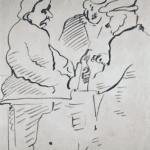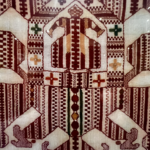The richly embroidered towels displayed in this exhibition were produced in the Vologda region in the late 19th and early 20th century. These remarkable works of peasant art preserve the ancient symbolism of Russia’s pre-Christian past. Stitched by peasant women for domestic use, their designs convey a sense of an age-old community tradition. Russian towels have long been regarded as a unique source of historical knowledge about the times for which no written records have survived.
The towels are embroidered with a variety of fundamental embroidery techniques including the line stitch, filling stitch, and cross-stitch. Traditional northern embroidery was stitched with red thread made of linen or cotton on a natural linen background. Derived from krasa, the Russian word for beauty, the color red, or krasnyi, carried a significant symbolic meaning for peasant crafters. It was associated with two vital forces: the life-giving warmth of the sun and the energy of human blood.
The symbolic language of Russian embroidery is a system of writing where paper and ink are replaced by cloth and thread. As in all traditional crafts, the patterns of embroidery were strictly regulated by tradition, and no random details were allowed. As the celebrated scholar of Russian decorative arts Vasili Stasov wrote, “In ancient times, decorative patterns did not have a single idle element; every stitch had a significance of its own, familiar to its makers and users.” In the 19th century, when Russian embroidery began to be studied and collected, peasant weavers and seamstresses could not explain the meaning of the elaborate scenes they were creating on their handiwork, but they strictly followed the old customs, reproducing ancient patterns in minute detail.
In Russian peasant households, embroidered towels were made for special occasions. Towels decorated the walls and icon corners of peasant homes. Towels were not only for private use, they were also part of public rituals. During droughts, epidemics and other disasters, the women of the village gathered at dawn to spin, weave and embroider the obydennoe or one-day towel, believed to ward off evil. It was believed that the obydennoe towel had to be completed in one day in order for it to possess this power. Towels played prominent roles in village holidays and celebrations. Honored guests are still greeted in Russian homes with a round loaf of bread and a saltcellar displayed on a long, richly decorated towel.





You must be logged in to post a comment.